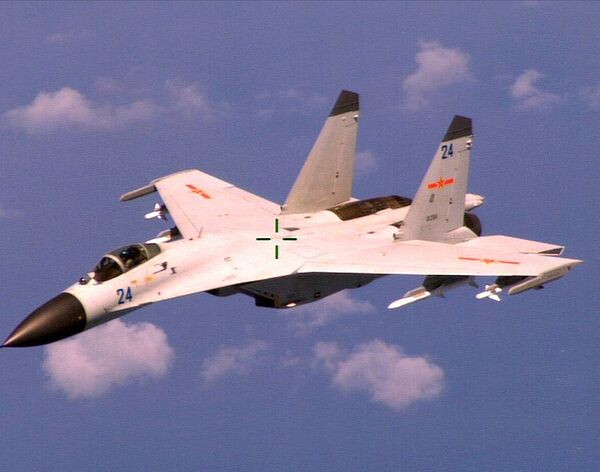
TOKYO – Japan has lodged a strong protest with China regarding incidents on Wednesday and Thursday where Chinese fighter jets made close approaches to Japan Air Self-Defense Force (JASDF) electronic intelligence (ELINT) aircraft. Tokyo expressed serious concern that these dangerous actions could lead to accidental collisions and strongly urged Beijing to prevent their recurrence.
The Japanese Ministry of Defense (MOD) issued a statement on Thursday announcing the unusually close approaches by Chinese military aircraft. According to the statement, a Chinese JH-7 fighter-bomber approached a JASDF YS-11EB ELINT aircraft, which was conducting surveillance in international airspace over the East China Sea, for approximately 15 minutes between 10:15 AM and 11:05 AM on Wednesday. At the time, the JH-7 flew as close as approximately 30 meters horizontally and 60 meters vertically to the YS-11EB.
Then, on Thursday, another Chinese JH-7 fighter-bomber again approached a JASDF YS-11EB conducting surveillance over the East China Sea for about 10 minutes from 10:00 AM. This time, it reportedly came within approximately 60 meters horizontally and 30 meters vertically. The MOD released a photo of the JH-7 fighter jet during Wednesday's incident, stating, "Such unusually close approaches by Chinese military aircraft could lead to accidental collisions, and we express serious concern and strongly urge for the prevention of their recurrence."
The YS-11EB is the last of approximately three YS-11 series aircraft operated by the JASDF. The YS-11 was produced as a civilian airliner from 1962 to 1974, and the JASDF and Japan Maritime Self-Defense Force (JMSDF) also operated military versions. These three YS-11EBs are assigned to the electronic reconnaissance squadron at Iruma Air Base on Honshu island.
Japan's Ministry of Foreign Affairs also stated on Thursday that Vice Foreign Minister Takehiro Funakoshi expressed Japan's serious concern over the incidents to Chinese Ambassador to Japan Wu Jianghao. Funakoshi emphasized that such actions could cause accidental collisions and strongly urged the Chinese government to prevent similar actions from recurring.
China's Silence and Repeated Tensions
China has not yet issued an official statement regarding these incidents. Last month, Japan also protested dangerous actions by J-15 fighter jets operating from the Chinese People's Liberation Army Navy (PLAN) aircraft carrier Shandong (17) against a JMSDF P-3C Orion maritime patrol aircraft (MPA) that was tracking the Shandong carrier strike group in the Philippine Sea. At the time, the Chinese Foreign Ministry stated that Japan's close-range reconnaissance of Chinese military activities was the fundamental cause of maritime security risks and urged Japan to cease such actions.
In response, Japanese Defense Minister Kishi Nobuo countered, "JASDF aircraft do not approach other aircraft within 45 meters in international waters. We cannot accept the Chinese side's statement that Japan is responsible for this incident, and we have properly conveyed Japan's position to the Chinese side." Defense Minister Kishi has not yet publicly commented on this latest incident.
Chinese aircraft have repeatedly conducted unstable aerial interceptions and aerial harassment in the South China Sea and East China Sea in the past. In the South China Sea, these actions are related to what is considered an infringement of Chinese territorial airspace, while in the East China Sea, they are actions against vessels and aircraft monitoring violations of UN sanctions against North Korea. China has previously claimed that surveillance activities were disguised reconnaissance against China, but Japan has not disclosed any details regarding the purpose of the YS-11EB's operations in the East China Sea. Maritime air surveillance of Chinese and Russian naval vessels is typically carried out by JMSDF's P-1 and P-3C MPAs.
Growing Concerns Over Regional Instability
In addition to incidents involving Japan, there have been two publicly reported incidents this year, both occurring in the South China Sea in February. On February 11, a People's Liberation Army Air Force (PLAAF) J-16 fighter jet launched flares 30 meters in front of a Royal Australian Air Force (RAAF) P-8A Poseidon MPA patrolling the South China Sea. Also, on February 18, a PLAN Z-9 helicopter made a close approach and intercepted a Philippine Bureau of Fisheries and Aquatic Resources Cessna 208B Grand Caravan over Scarborough Shoal.
This series of incidents indicates escalating military tensions in the East Asia and South China Sea regions. As countries assert their interests and intensify military activities, the risk of accidental collisions grows. A lack of transparency and the absence of clear communication channels further amplify these risks. For regional stability and peace, it is urgent that the relevant countries exercise restraint and seek to resolve issues through dialogue.
[Copyright (c) Global Economic Times. All Rights Reserved.]






























